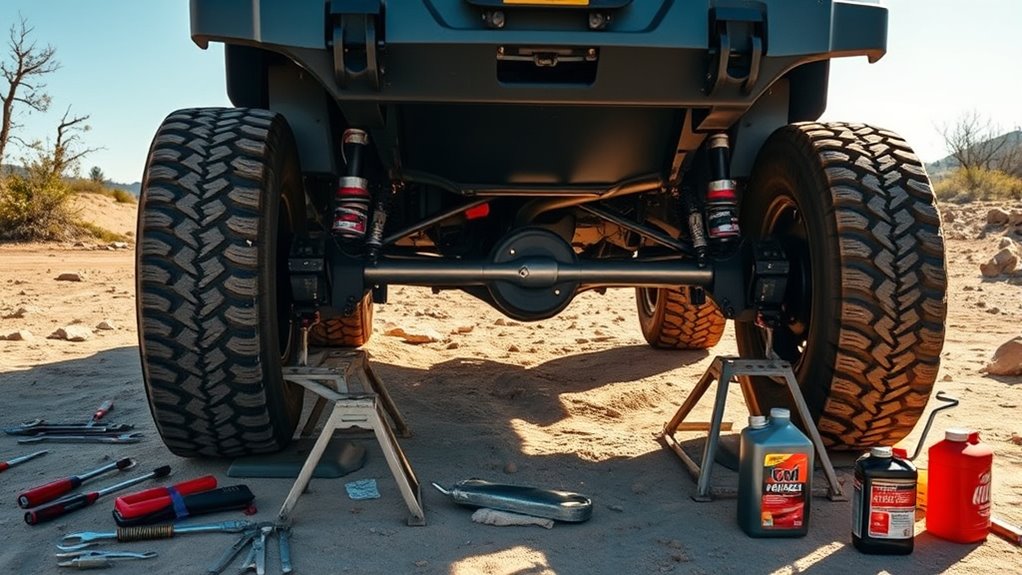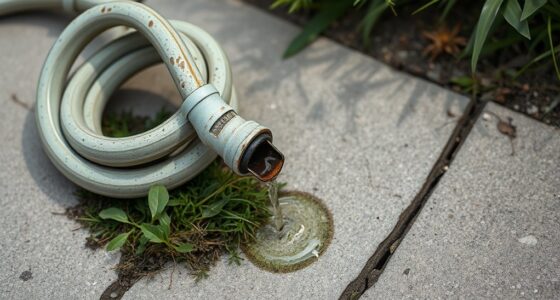To keep your 4×4 trail-ready, you should regularly rotate your tires, check and top off fluids like oil and coolant, and inspect key components such as brakes, suspension, and the undercarriage for damage or wear. Keep your air filters clean, especially after muddy rides, and maintain vehicle cleanliness to spot issues early. Staying proactive with these basics guarantees your vehicle performs reliably on tough trails—continue exploring these tips to stay ahead of the dirt and dust.
Key Takeaways
- Perform regular tire rotations every 3,000 to 5,000 miles to ensure even tread wear and extend tire life.
- Check and top off essential fluids like engine oil, coolant, and transmission fluids before each off-road trip.
- Inspect suspension, brakes, and undercarriage for damage or wear after rough terrain to prevent breakdowns.
- Maintain air filters frequently, especially after dusty or muddy rides, to protect the engine from debris.
- Keep the vehicle clean and visually inspected to spot issues early and ensure it remains trail-ready and reliable.

Maintaining your off-road vehicle is essential for ensuring it performs reliably and safely during every adventure. When you’re tackling rugged trails, you need your 4×4 to be in top shape, and that starts with routine maintenance. One of the most straightforward yet impactful tasks is tire rotation. By regularly rotating your tires, you help guarantee even tread wear, which boosts traction, improves handling, and extends the lifespan of your tires. Off-road driving can be tough on tires, so sticking to a schedule—typically every 3,000 to 5,000 miles or as recommended by your vehicle’s manufacturer—is vital. When rotating, pay special attention to the front and rear tires, as they wear differently depending on your driving style and terrain. Proper rotation not only saves you money in the long run but also guarantees your vehicle maintains ideal grip on uneven surfaces.
Alongside tire rotation, fluid checks are crucial to keep your off-road machine running smoothly. Fluids like engine oil, coolant, transmission fluid, and differential oil are the lifeblood of your vehicle. During each maintenance session, inspect these fluids for proper levels and signs of contamination or degradation. Low or dirty fluids can lead to overheating, increased wear, and even mechanical failure, especially when you’re traversing challenging terrain. Make it a habit to check fluid levels before each trip and top them off if needed. Consider changing your fluids according to the manufacturer’s recommended intervals, but also keep an eye on them after particularly grueling adventures. Regularly inspecting and maintaining your vehicle not only prevents unexpected breakdowns but also enhances overall vehicle longevity.
Beyond tire rotation and fluid checks, other maintenance steps will help keep your vehicle trail-ready. Regularly inspect your suspension components, brakes, and steering for signs of wear or damage. Clean your air filters often, especially after muddy or dusty excursions, to prevent debris from entering the engine. Check your skid plates, undercarriage, and body panels for dents or loose bolts, as off-road driving often results in impacts and vibrations. Keeping your vehicle clean after each outing not only preserves its appearance but also makes it easier to spot issues early. Staying proactive with these basic maintenance tasks ensures your 4×4 remains reliable and safe, ready to conquer the next trail with confidence.
Frequently Asked Questions
How Often Should I Change My Off-Road Vehicle’S Differential Fluid?
You should change your off-road vehicle’s differential fluid according to the maintenance schedule in your owner’s manual, typically every 30,000 to 50,000 miles. Regularly checking the differential fluid helps prevent gear wear and overheating. If you drive in harsh conditions like mud or water crossings, consider changing it more often. Staying on top of differential fluid maintenance guarantees your 4×4 remains dependable and prepared for the trail.
What’S the Best Way to Check Tire Tread Depth for Off-Road Use?
Think of your tire tread as the trail map guiding your adventure. To check tread wear, use a penny or a tread depth gauge—insert the coin into the tread, and if Lincoln’s head is visible, it’s time to replace. Remember, proper tire pressure guarantees even tread wear, so regularly inspect and adjust it. Keeping your tread deep and even guarantees better grip, safety, and a smoother off-road journey.
How Do I Prevent Rust on Undercarriage Components?
To prevent rust on your undercarriage components, you should regularly clean off mud, dirt, and salt that can cause corrosion. Applying a rust prevention coating or undercarriage protection spray creates a barrier against moisture and rust. You also want to inspect for any damage or chips in protective coatings and address them promptly. Consistent maintenance keeps your 4×4’s undercarriage in top shape and extends its lifespan.
Are Aftermarket Parts Reliable for Off-Road Vehicle Repairs?
While aftermarket parts can offer appealing options, they may not always match the reliability of OEM components. You should consider the brand reputation and warranty coverage, as trusted brands tend to produce durable parts that withstand off-road challenges. Though some aftermarket options can be dependable, it’s wise to research reviews and supplier reputation to guarantee your repairs hold up on rugged trails, keeping your adventure safe and worry-free.
What’S the Ideal Maintenance Schedule After a Muddy Trail Run?
After a muddy trail run, you should perform a thorough maintenance routine. Start with a muddy trail inspection, checking for mud buildup in your wheels, suspension, and undercarriage. Follow with post-ride cleaning to remove dirt and debris, preventing corrosion and damage. Then, inspect fluids, brakes, and tires. Doing this promptly keeps your 4×4 in top shape, ready for your next adventure and avoiding costly repairs down the line.
Conclusion
By staying on top of regular maintenance, you’ll keep your 4×4 ready to conquer any trail like a well-oiled machine. Think of your vehicle as a trusty steed—if you care for it properly, it’ll carry you through rugged terrains without a hitch. Remember, a little effort now prevents big problems later. So, make maintenance a habit, and your off-road adventures will stay smooth, safe, and as exciting as your first ride.









